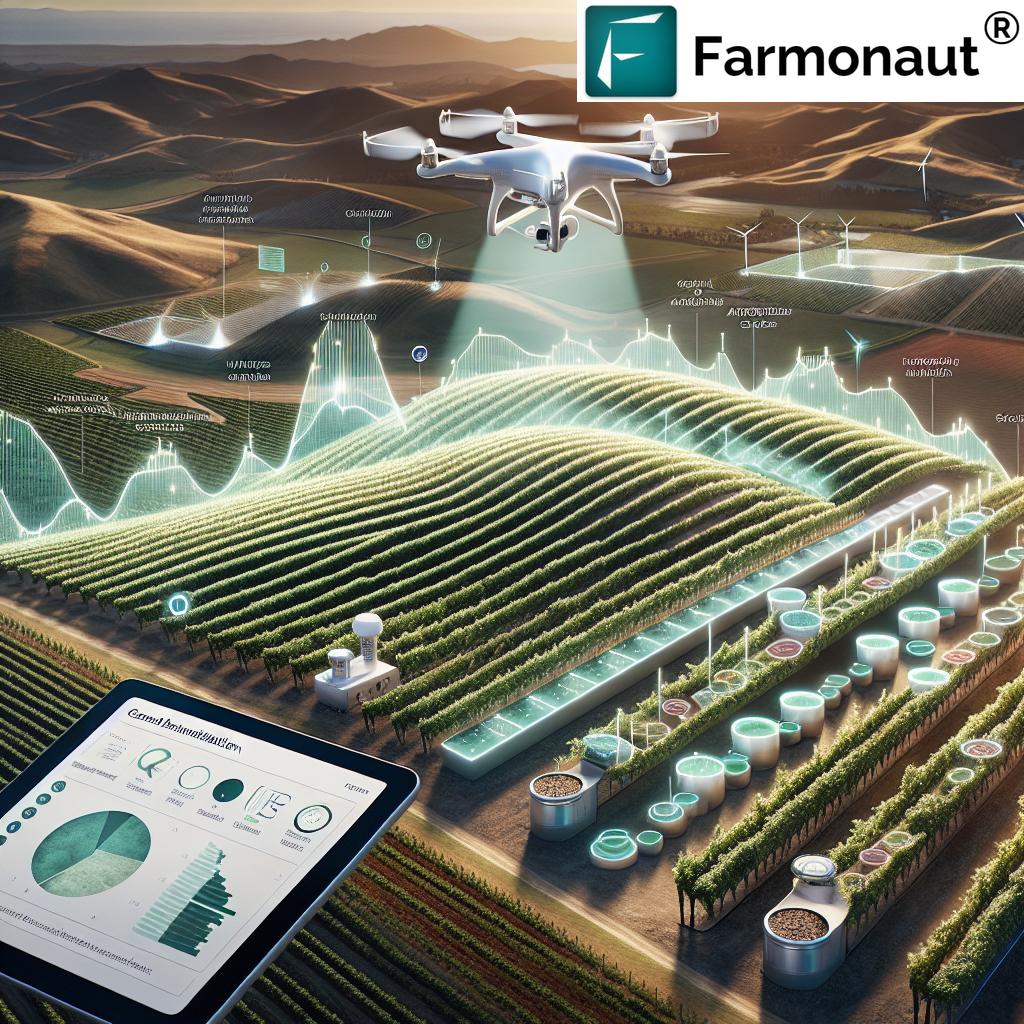Revolutionizing Australian Wine Exports: How GIS and AgTech are Transforming Vineyard Management and Sustainability
“Australian wine exports reached 615 million liters in 2022, with GIS-aided vineyard management contributing to a 10% yield increase.”
Welcome to the exciting world of Australian wine exports, where tradition meets innovation in a perfect blend of flavor and technology. In this comprehensive guide, we’ll explore how Geographic Information Systems (GIS) and Agricultural Technology (AgTech) are transforming vineyard management and sustainability practices, revolutionizing the Australian wine industry and its position in the global market.
The Australian Wine Export Landscape
Australia has long been renowned for its high-quality wines, with a rich history of viniculture dating back to the early 19th century. Today, the Australian wine sector is a vital component of the country’s agricultural exports, contributing significantly to the national economy. As we delve into the intricacies of this thriving industry, we’ll uncover how modern technologies are reshaping traditional practices and opening up new possibilities for Australian winemakers.
GIS in Viticulture: A Game-Changer for Vineyard Management
Geographic Information Systems (GIS) have emerged as a powerful tool in vineyard management, offering unprecedented insights into the spatial and temporal aspects of wine production. Let’s explore how GIS is revolutionizing various aspects of viticulture:
- Precision Mapping: GIS allows for highly accurate mapping of vineyard layouts, soil types, and topography, enabling winemakers to optimize planting strategies and resource allocation.
- Climate Analysis: By integrating climate data with geographical information, GIS helps predict microclimates within vineyards, crucial for varietal selection and harvest timing.
- Water Management: GIS-based irrigation systems optimize water usage, a critical factor in sustainable winegrowing practices, especially in drought-prone regions of Australia.
- Pest and Disease Control: Early detection and targeted treatment of vineyard issues are made possible through GIS-enabled monitoring systems, reducing the need for broad-spectrum pesticides.
The integration of GIS in viticulture has not only improved the efficiency of vineyard operations but also contributed to the overall quality and consistency of Australian wines, a key factor in maintaining their competitive edge in international markets.

AgTech Solutions Transforming Winemaking
Beyond GIS, a wide array of AgTech solutions are making waves in the Australian wine industry. These innovative technologies are not only enhancing production processes but also addressing key challenges in sustainability and market competitiveness:
- Drone Technology: Unmanned aerial vehicles equipped with multispectral cameras provide detailed imagery for crop health assessment and yield estimation.
- IoT Sensors: Internet of Things (IoT) devices monitor crucial parameters like soil moisture, temperature, and humidity in real-time, allowing for data-driven decision-making.
- AI and Machine Learning: Advanced algorithms analyze vast datasets to predict optimal harvest times, detect early signs of disease, and even forecast market trends.
- Robotic Harvesters: Automated harvesting machines increase efficiency and reduce labor costs, particularly beneficial for large-scale vineyards.
These AgTech solutions are not just improving operational efficiency; they’re also playing a crucial role in enhancing the quality and consistency of Australian wines, key factors in maintaining a strong position in the international wine trade.
Sustainable Winegrowing: A Cornerstone of Australian Wine Exports
“Sustainable winegrowing practices have reduced water usage in Australian vineyards by 30% over the past decade.”
Sustainability has become a central focus in the Australian wine industry, driven by both environmental concerns and market demands. Let’s explore how sustainable winegrowing practices are shaping the future of Australian wine exports:
- Water Conservation: Innovative irrigation techniques and drought-resistant grape varieties are helping wineries reduce water usage without compromising quality.
- Organic and Biodynamic Practices: Many Australian vineyards are adopting organic and biodynamic farming methods, appealing to environmentally conscious consumers in global markets.
- Carbon Footprint Reduction: From solar-powered wineries to lightweight packaging, the industry is making strides in reducing its carbon emissions.
- Biodiversity Enhancement: Eco-friendly vineyard practices, such as cover cropping and habitat corridors, are promoting biodiversity and natural pest control.
These sustainable practices not only contribute to environmental preservation but also add value to Australian wines in international markets, where eco-conscious consumers are increasingly influential.
Navigating Wine Export Regulations and Labelling Requirements
Exporting wine from Australia involves navigating a complex landscape of regulations and labelling requirements. Here’s what Australian wine exporters need to know:
- Export Documentation: Proper documentation, including export licenses and certificates of origin, is crucial for smooth international trade.
- Labelling Compliance: Australian wine labels must adhere to both domestic and destination country regulations, including information on alcohol content, volume, and geographical indications.
- Quality Control Measures: Rigorous quality control processes ensure that exported wines meet international standards and maintain Australia’s reputation for excellence.
- Geographical Indications: Protected geographical indications play a significant role in marketing Australian wines and must be accurately represented on labels.
Understanding and complying with these regulations is essential for Australian wine exporters to successfully navigate global markets and maintain the integrity of their products.
Wine Tourism and Marketing Strategies
Wine tourism has become an integral part of the Australian wine industry, complementing export efforts and enhancing brand recognition. Let’s explore some effective strategies:
- Cellar Door Experiences: Many wineries offer unique tasting experiences, attracting both domestic and international visitors.
- Wine Trails: Collaborative efforts between wineries and tourism boards create attractive wine routes, showcasing regional diversity.
- Digital Marketing: Social media campaigns and virtual tastings extend the reach of Australian wines to global audiences.
- Wine Education Programs: Offering educational experiences about Australian wines and winemaking processes enhances consumer engagement and loyalty.
These marketing strategies not only boost domestic sales but also contribute to the international reputation of Australian wines, supporting export growth.

Climate Change and Viticulture: Adapting for the Future
Climate change presents significant challenges to the Australian wine industry, necessitating adaptive strategies:
- Varietal Adaptation: Experimenting with grape varieties that are better suited to warmer climates.
- Canopy Management: Advanced techniques to protect grapes from excessive heat and sunlight.
- Water Management: Implementing water-efficient irrigation systems and drought-resistant rootstocks.
- Shifting Growing Regions: Exploring cooler climate regions for grape cultivation to maintain wine quality.
By proactively addressing climate challenges, the Australian wine industry is working to ensure the long-term sustainability and quality of its exports.
Farmonaut’s Role in Transforming Australian Viticulture
In the context of this technological revolution in Australian viticulture, Farmonaut’s satellite-based farm management solutions offer valuable tools for vineyard managers and winemakers. By leveraging advanced satellite imagery and AI-driven insights, Farmonaut provides:
- Real-time Crop Health Monitoring: Enabling early detection of issues in vine health and growth.
- Precision Resource Management: Optimizing irrigation and fertilizer usage based on data-driven insights.
- Climate Adaptation Tools: Assisting vineyards in managing the impacts of changing weather patterns.
- Sustainability Tracking: Monitoring and reporting on environmental metrics to support sustainable winegrowing practices.
Farmonaut’s technology aligns perfectly with the needs of modern Australian vineyards, supporting their efforts to enhance quality, sustainability, and export competitiveness.
The Future of Australian Wine Exports
As we look to the future, the Australian wine export sector is poised for continued growth and innovation. Key trends and initiatives shaping the industry include:
- Market Diversification: Expanding into emerging markets while strengthening presence in traditional ones.
- Technological Integration: Further adoption of GIS, AgTech, and AI solutions in all aspects of wine production and export.
- Sustainability Leadership: Positioning Australian wines as leaders in sustainable and eco-friendly production.
- Quality Focussed Innovation: Continual improvement in winemaking techniques to maintain premium quality standards.
These forward-looking strategies will be crucial in maintaining Australia’s position as a leading wine exporter in an increasingly competitive global market.
Comparative Analysis: Traditional vs. Technology-Enabled Vineyard Management
| Vineyard Management Aspect | Traditional Methods | Farmonaut Satellite System |
|---|---|---|
| Irrigation Efficiency | 60-70% efficiency | 85-95% efficiency, saving up to 30% water usage |
| Disease Detection | Manual inspection, often reactive | Early detection via satellite imagery, proactive management |
| Yield Estimation | +/- 20% accuracy | +/- 5% accuracy with AI-assisted analysis |
| Sustainability Practices | Limited data-driven decisions | Comprehensive sustainability tracking and reporting |
| Export Quality Control | Periodic sampling | Continuous monitoring throughout growing season |
Conclusion
The Australian wine export industry stands at the forefront of innovation, embracing GIS, AgTech, and sustainable practices to enhance quality, efficiency, and market competitiveness. As we’ve explored, from vineyard management to international market strategies, technology is playing a pivotal role in shaping the future of Australian wines on the global stage.
By leveraging advanced tools like Farmonaut’s satellite-based solutions, Australian winemakers are not only improving their production processes but also addressing critical challenges such as climate change and sustainability. This technological revolution, combined with Australia’s rich winemaking heritage, positions the industry for continued success in the international wine trade.
As we raise a glass to the future of Australian wine exports, we toast to a blend of tradition and innovation, promising exciting developments for producers and wine enthusiasts alike.
FAQ Section
Q: How is GIS transforming vineyard management in Australia?
A: GIS is revolutionizing vineyard management by providing precise mapping, climate analysis, efficient water management, and improved pest and disease control. This technology enables winemakers to make data-driven decisions, optimize resource allocation, and enhance overall wine quality.
Q: What are some key sustainable winegrowing practices in Australia?
A: Key sustainable practices include water conservation through innovative irrigation techniques, adoption of organic and biodynamic farming methods, carbon footprint reduction initiatives, and biodiversity enhancement strategies such as cover cropping and habitat corridors.
Q: How are Australian wineries adapting to climate change?
A: Australian wineries are adapting to climate change through varietal adaptation, advanced canopy management techniques, water-efficient irrigation systems, and exploration of cooler climate regions for grape cultivation.
Q: What role does Farmonaut play in Australian viticulture?
A: Farmonaut provides satellite-based farm management solutions that offer real-time crop health monitoring, precision resource management, climate adaptation tools, and sustainability tracking, all of which are crucial for modern vineyard management and enhancing export competitiveness.
Q: What are the main challenges in Australian wine exports?
A: Main challenges include navigating complex export regulations, meeting diverse labelling requirements, maintaining quality control across different markets, and adapting to changing consumer preferences and climate conditions.


















